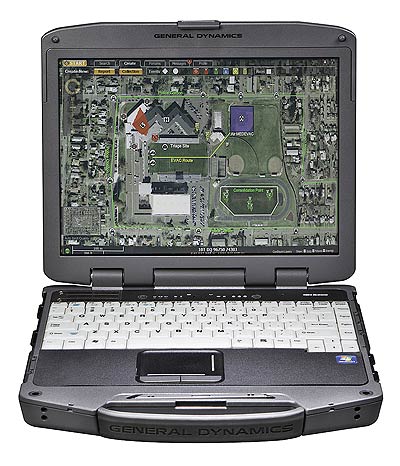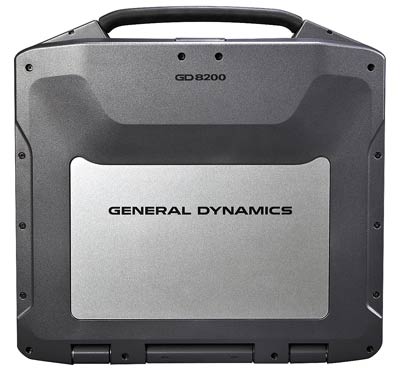On June 7, 2011, General Dynamics Itronix introduced the GD8200, a fully rugged notebook computer and apparent successor to the company's GD8000 model (first announced early 2009). The new machine includes a variety of technology, performance and ruggedness updates designed to freshen up the platform while retaining complete backward compatibility with prior model infra structures, programming and peripherals.

So how did Itronix update their flagship ultra-rugged platform without making it incompatible with earlier models? By examining every component and subsystem for weaknesses or the availability of improved technology. And then improving accordingly.

Without having benchmarked it yet, we're confident that in terms of overall performance, the new GD8200 represents a major step forward. This is due in part to a general advance in technology, but in part also to a subtle shift in positioning. What do we mean by that? Well, in the past Itronix generally offered the most powerful notebooks in its class, but that came at the expense of battery life. To address that, the immediate predecessor of the new GD8200, the GD8000, provided a more balanced combination of performance, ruggedness, usability and battery life via a frugal Core 2 Duo SL9400 processor running at just 1.86GHz. Perhaps that was a bit too frugal, and so the new GD8200 has an entirely more perky Core i7-2655LE under the hood. That chip, part of Intel's 2nd gen Core i7 processor lineup, runs at 2.2GHz and can go as high as 2.9GHz in Turbo Boost mode. But won't battery life suffer from this hotter running (25 watts vs. 17 watts) chip? Apparently not. Itronix quotes the same 8 hours of running time on a charge as for the old machine. And if that is not enough, the GD8200's media bay can accommodate a second (smaller) battery that boosts battery life to an astounding 12 hours.
Since the overall form factor of the GD8200 is exactly the same as that of the outgoing GD8000 (i.e. 12.0 x 11.5 x 2.4 inches), you'd expect the display to be unchanged, and it is, physically at least. It still measures 13.3 inches diagonally and still uses the old 4:3 aspect ratio that so long dominated all things computing. Unchanged also is the 1024 x 768 pixel XGA display resolution. That's good for those with lots of legacy software, but it's starting to be a bit on the low side of what's needed with today's complex apps and websites. Another thing we'd have liked to see in a new model is discrete graphics, at least as an option. Discrete graphics can speed 3D and OpenGL grahics up tremendoulsy, as evidenced by GD-Itronix's own Nomad computer; a fact also acknowledged by the competition over at Panasonic and Getac (see RuggedPCReview.com view on discrete graphics).
There's good news, too, in the display department though. The Intel HD Graphics 3000 circuitry that's part of the Core i7 chip speeds up overall graphics performance. The specs also refer to a new version II of the company's vaunted DynaVue technology (see RuggedPCReview description of DynaVue: The Ultimate Outdoor-Readable Touch-Screen Display), but it is not clear what has been changed and enhanced. Do note that GD-Itronix did pioneering work in this area in identifying and optimizing components that result in the highest possible effective display contrast ratio, and we'll report on Rev. 2.0 of the technology in detail as soon as we have all the facts.
Additional technology updates include:
- Faster DDR3 memory
- Larger hard disks (500 or 750GB heated, up from 160/320GB)
- Optional 500GB hybrid drive
- A USB 3.0 port (for up to 10 times the throughput of USB 2.0)
- Bluetooth v2.1 (reduced power consumption, increased security)
- 4G support
As far as ruggedness goes, the GD8000 was already a formidable piece of equipment and GD-Itronix was one of the first to perform drop tests on a single, operating machine as opposed to an allowable pool of five non-operating machines.
During GD8000 testing, GD-Itronix also felt that the commonly used testing methods didn't make much sense as most units fail as a result of being "washed off," i.e. subjected to a LOT of water, or as a result of being rained on, which means less water but potentially over a long period of time. So in addition to the ANSI/IEC Ingress Protection test, they subjected the original GD8000 unit to testing described in MIL-STD-810F 506.4 Procedure II, which mandates a full four hours of exposure to dripping water, and not just the 15 minutes in the often-used Procedure III. That resulted in an IP64 rating for the GD8000, and meant total sealing against dust and against eater spray from all directions, but with "limited ingress permitted." The GD8200 now carries an IP65 rating, which means protection against water jets as opposed to just spray, but still with limited ingress permitted. We're not sure how Itronix tested this time, but protection is up some.
Overall, GD-Itronix knows what its mandate is, and that the #1 customer concern is to "keep it in the field." Deployed machines must not fail and cause costly downtime. They designed the GD8000 around that, and with an additional two-plus years of experience when designing the GD8200, this one's likely even better.
There's no specific mention in the press release or specs, but the GD8200 was likely also tested for vibration, extreme temperatures, altitude, humidity and so. It does say that the machine is certified to operate in helicopters, withstand electromagnetic emissions and has passed rigorous crash testing for in-vehicle occupant safety. GD-Itronix no longer has the Spokane testing lab and we're not sure if the Sunrise facilities have their own testing chambers, or if it's all done via independent third party testing now.
On the wireless side things never stand still, and so there are significant changes in the new GD8200. WiFi has changed to Intel's Advanced-N 6205 (see here). Itronix has always prided itself in its specially designed, integrated and field-replaceable CRMA Express radio modules that had distinct advantages over standard PC Card-based radio modules. CDMA EV-DO Rev A/GSM/GPRS/EDGE/ WCDMA/HSPA+ support is all available, as is 4G LTE and SiRFstarIII-based GPS with a high performance quadrifilar helix antenna. While the GD8000 was listed as Gobi2000 ready, Gobi is no longer mentioned.
Security has been enhanced beyond the usual TPM 1.2 and different levels of passwords. There's the fingerprint reader, optional CompuTrace theft recovery and data protection agent in BIOS, FIPS201-compliant Smart Card reader, and also a variety of Intel technologies such as Intel vPro and Intel Anti-Theft.
So that's the GD8200. It must be a bit frustrating to companies like GD-Itronix that Intel's rapid chip release/obsolescence cycle pretty much puts anyone who does not keep up with the latest Intel chips at a competitive disadvantage. On the plus side, these more or less forced frequent updates give companies an opportunity to integrate other new and improved technology, bring the overall design up-to-date, and also fix whatever may not have worked so well in a predecessor.
There wasn't much to fix on the GD8000, and so the GD8200 extends the inherent goodness of that machine, but presents it with more modern technology and a whole lot more performance.



